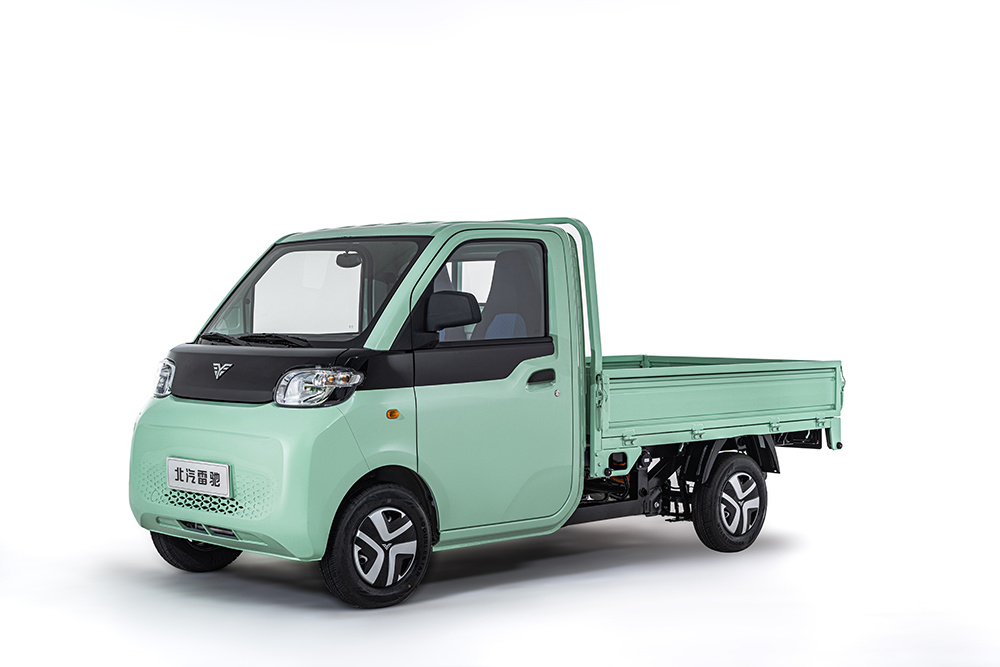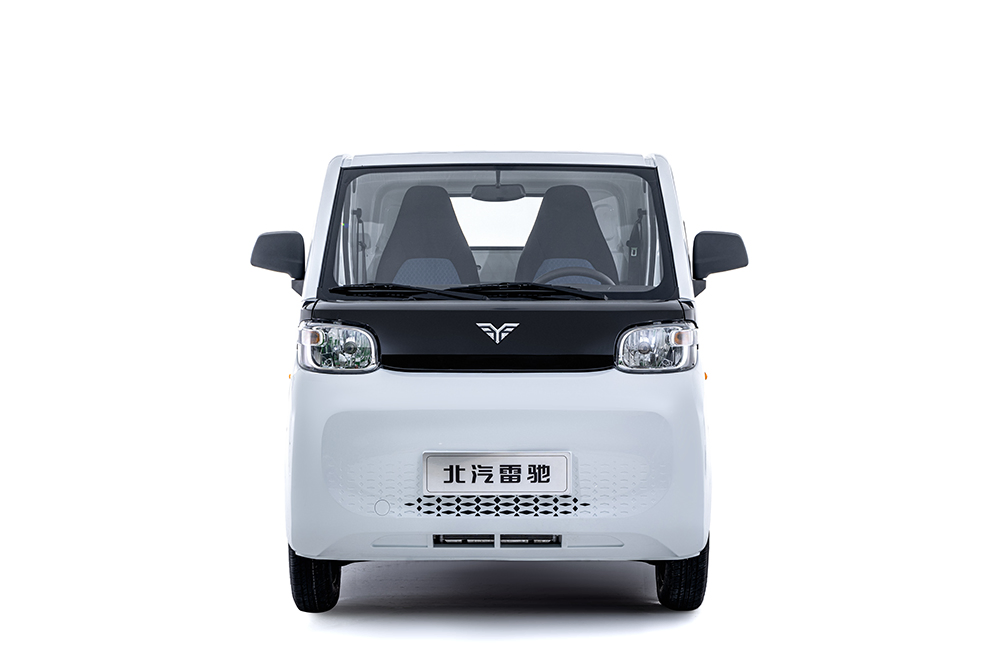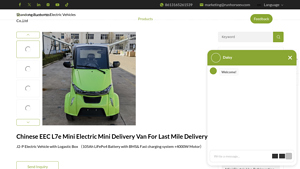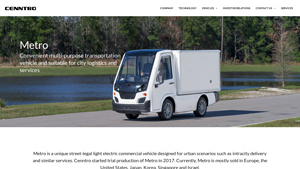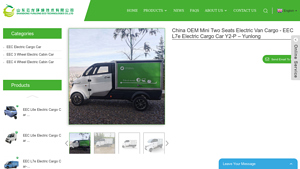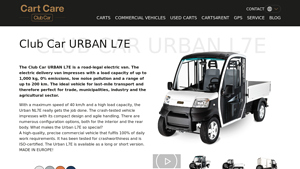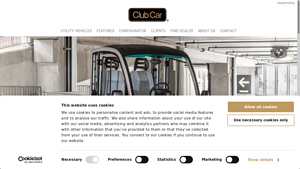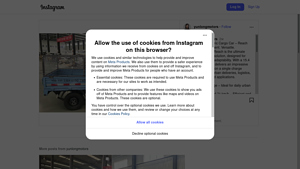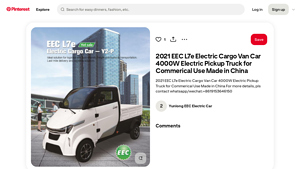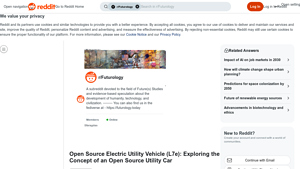Introduction: Navigating the Global Market for van l7e
In today’s rapidly evolving landscape, sourcing the right electric delivery van, particularly the L7e model, poses a unique challenge for international B2B buyers. As businesses increasingly prioritize sustainability and efficiency, the demand for compact, electric vehicles tailored for urban logistics has surged. This guide is designed to equip you with the insights necessary to navigate the complexities of the global market for L7e vans, covering a spectrum of topics including types of vehicles, their applications, supplier vetting processes, and cost considerations.
By delving into the specifics of L7e vans, such as their capabilities in last-mile delivery and adaptability to various operational needs, this guide empowers buyers from regions like Africa, South America, the Middle East, and Europe—particularly Germany and Nigeria—to make informed purchasing decisions. Whether you are looking for a mini electric delivery van that offers low operational costs or a versatile model that can handle diverse cargo types, this comprehensive resource ensures that you understand the market dynamics and available options.
With insights into supplier reliability and product specifications, you will be better equipped to select vehicles that align with your business objectives and sustainability goals. The global shift towards electric mobility is not just a trend; it’s a pivotal opportunity for businesses to innovate and thrive in a competitive marketplace.
Understanding van l7e Types and Variations
| Type Name | Key Distinguishing Features | Primary B2B Applications | Brief Pros & Cons for Buyers |
|---|---|---|---|
| Mini Electric Delivery Van | Compact size, high maneuverability, electric powertrain | Last-mile delivery, urban logistics | Pros: Cost-effective, eco-friendly; Cons: Limited cargo space compared to larger vans. |
| Multi-Purpose Light Electric Van | Versatile configurations (cargo boxes, refrigerated) | Urban services, food delivery, logistics | Pros: Customizable, low maintenance; Cons: May require additional investment for modifications. |
| Four-Seater L7e Electric Van | Lightweight, four-seat capacity, eco-design | Shuttle services, small group transport | Pros: Innovative design, recyclable materials; Cons: Limited speed and power compared to traditional vans. |
| Compact Electric Cargo Van | High payload capacity, designed for urban use | E-commerce, retail deliveries | Pros: Efficient for city deliveries, low operating costs; Cons: Limited range may affect longer trips. |
| Electric Pickup Truck | Robust design, high cargo capacity | Construction, landscaping, utility services | Pros: Versatile utility, strong performance; Cons: Higher upfront cost compared to smaller models. |
What are the Characteristics of the Mini Electric Delivery Van?
The Mini Electric Delivery Van is characterized by its compact dimensions and maneuverability, making it ideal for urban environments. With an electric powertrain, it operates quietly and reduces carbon emissions, aligning with sustainability goals. This type is particularly suited for last-mile delivery services, where navigating congested streets is essential. Buyers should consider the limited cargo space relative to larger vans, which may restrict the volume of goods transported in one trip.
How Does the Multi-Purpose Light Electric Van Stand Out?
The Multi-Purpose Light Electric Van is notable for its versatility, allowing for various configurations such as cargo boxes and refrigerated units. This adaptability makes it suitable for diverse applications, including urban services and food delivery. B2B buyers can benefit from its low maintenance costs and the ability to customize the vehicle according to specific operational needs. However, potential buyers should be aware that extensive modifications may require additional investment.
What Benefits Does the Four-Seater L7e Electric Van Offer?
The Four-Seater L7e Electric Van is a distinctive option in the L7e category, combining lightweight design with four-seat capacity. This vehicle is particularly advantageous for shuttle services and small group transport, providing an eco-friendly alternative to traditional vans. Its innovative use of recyclable materials appeals to environmentally conscious businesses. However, the van’s maximum speed and power may not meet the demands of all commercial applications, which is a consideration for buyers.
Why Choose the Compact Electric Cargo Van?
Designed for urban use, the Compact Electric Cargo Van offers a high payload capacity while being efficient for city deliveries. Its electric nature results in lower operating costs compared to traditional fuel-powered vehicles, making it an attractive option for e-commerce and retail deliveries. Buyers should consider the limited range of these vans, as it may affect operations that require longer travel distances. Nonetheless, their efficiency in urban environments can lead to significant cost savings.
What Makes the Electric Pickup Truck a Viable Option?
The Electric Pickup Truck is known for its robust design and high cargo capacity, making it suitable for construction, landscaping, and utility services. Its versatility allows businesses to transport various types of equipment and materials effectively. While the initial investment may be higher than that of smaller electric vans, the long-term operational savings and reduced maintenance costs can justify the expense. Buyers should evaluate their specific needs to determine if this type of vehicle aligns with their operational requirements.
Key Industrial Applications of van l7e
| Industry/Sector | Specific Application of van l7e | Value/Benefit for the Business | Key Sourcing Considerations for this Application |
|---|---|---|---|
| E-commerce & Retail | Last-Mile Delivery Vehicles | Enhances delivery efficiency and reduces operational costs. | Battery range, cargo capacity, and vehicle dimensions. |
| Urban Logistics & Distribution | Urban Freight Transport | Ideal for navigating congested city environments while carrying sizable loads. | Local regulations, charging infrastructure, and maintenance support. |
| Food & Beverage | Mobile Food Distribution | Facilitates quick and efficient food delivery services. | Temperature control capabilities and hygiene compliance. |
| Construction & Maintenance | On-Site Material Transport | Streamlines logistics by transporting tools and materials to construction sites. | Payload capacity and durability for rough terrain. |
| Tourism & Hospitality | Shuttle Services for Tourists | Provides eco-friendly transport options for guest services. | Comfort features, seating capacity, and local compliance. |
How is the van l7e Used in E-commerce & Retail for Last-Mile Delivery?
In the e-commerce and retail sectors, the van l7e serves as an efficient last-mile delivery vehicle. Its compact size allows for easy navigation through urban environments, reducing delivery times and costs. Businesses benefit from its electric operation, which lowers fuel expenses and aligns with sustainability goals. International buyers should consider battery range and cargo capacity, ensuring the vehicle meets the demands of their delivery routes.
What Role Does the van l7e Play in Urban Logistics & Distribution?
The van l7e is particularly well-suited for urban logistics and distribution, where space is often limited and traffic congestion is common. Its design allows for maneuverability in tight spaces while providing ample cargo capacity for goods. This vehicle can help businesses optimize their distribution processes, leading to enhanced service levels and reduced operational costs. Buyers should be aware of local regulations regarding electric vehicles and available charging infrastructure to ensure seamless integration into their logistics operations.
How Can the van l7e Support Food & Beverage Distribution?
In the food and beverage industry, the van l7e can be utilized for mobile food distribution, enabling businesses to deliver fresh products efficiently. Its electric powertrain not only reduces carbon emissions but also offers cost savings on fuel. Buyers in this sector should prioritize temperature control capabilities and hygiene compliance to meet health regulations, ensuring that perishable goods are transported safely and effectively.
What Benefits Does the van l7e Provide for Construction & Maintenance?
The van l7e is an excellent choice for transporting materials and tools to construction sites, enhancing productivity by streamlining logistics. Its durability and payload capacity make it suitable for carrying heavy equipment across various terrains. Businesses should consider the vehicle’s robustness and adaptability to rough conditions, ensuring it can withstand the demands of construction work while providing reliable service.
How is the van l7e Used in Tourism & Hospitality?
In the tourism and hospitality sectors, the van l7e can serve as an eco-friendly shuttle service for guests, offering a unique transportation solution that aligns with sustainability initiatives. Its spacious interior can accommodate multiple passengers, enhancing the guest experience. Buyers should evaluate comfort features and seating capacity to ensure the vehicle meets the expectations of their clientele while complying with local transportation regulations.
3 Common User Pain Points for ‘van l7e’ & Their Solutions
Scenario 1: Navigating Regulatory Compliance for L7e Vehicles
The Problem: B2B buyers often face significant challenges in ensuring that their L7e vehicles comply with local regulations. Different countries and regions have varying standards regarding vehicle specifications, emissions, and safety features. This complexity can lead to costly delays in procurement and operational inefficiencies, as buyers may inadvertently purchase vehicles that do not meet the necessary legal requirements.
The Solution: To effectively navigate this issue, buyers should prioritize thorough research into the specific regulations governing L7e vehicles in their target markets. Engaging with local regulatory bodies or consulting firms specializing in automotive compliance can provide invaluable insights. Additionally, working closely with manufacturers who have experience in the local market can ensure that the vehicles sourced are already compliant. Buyers should also consider investing in a robust tracking system to monitor changes in regulations and ensure ongoing compliance. This proactive approach not only mitigates risks but also enhances the credibility and operational readiness of the business.
Scenario 2: Managing Total Cost of Ownership (TCO) for Electric Vans
The Problem: Many B2B buyers underestimate the total cost of ownership associated with L7e electric vans. While the initial purchase price may seem attractive, ongoing costs related to maintenance, charging infrastructure, and battery replacement can significantly impact profitability. Businesses operating in regions with limited charging infrastructure may also incur additional costs for energy and operational downtime.
The Solution: To manage TCO effectively, buyers should conduct a comprehensive cost analysis before making a purchase. This analysis should include not only the upfront cost but also projections for maintenance, energy consumption, and potential infrastructure investments. Collaborating with energy providers to establish cost-effective charging solutions can also yield long-term savings. Buyers should consider implementing a fleet management system that tracks vehicle performance and maintenance schedules, allowing for predictive maintenance and reducing unexpected costs. By taking a holistic view of TCO, businesses can make more informed decisions that enhance their bottom line.
Scenario 3: Ensuring Vehicle Adaptability for Diverse Use Cases
The Problem: As businesses evolve, their operational needs can change rapidly, leading to the challenge of ensuring that L7e vehicles can adapt to various use cases. Buyers may find that a vehicle which meets their current requirements may not be suitable for future applications, leading to wasted resources and inefficient fleet management.
The Solution: To overcome this challenge, B2B buyers should prioritize flexibility and adaptability in their vehicle selection process. When sourcing L7e vans, buyers should look for models that offer customizable configurations, such as varying cargo space, adjustable shelving, and adaptable loading capabilities. Engaging with manufacturers who provide modular solutions can also facilitate future modifications as business needs change. Additionally, establishing a feedback loop with drivers and operational teams can help identify new requirements and optimize vehicle use. By investing in adaptable L7e vehicles, businesses can future-proof their fleets and ensure they remain agile in a dynamic market environment.
Strategic Material Selection Guide for van l7e
What Are the Key Materials Used in the van l7e and Their Properties?
When selecting materials for the van l7e, it is crucial to consider their properties, manufacturing complexities, and suitability for various applications. Below are four common materials utilized in the construction of the van l7e, analyzed from a B2B perspective.
How Does Aluminum Benefit the van l7e’s Performance?
Aluminum is a popular choice for the van l7e due to its excellent strength-to-weight ratio and corrosion resistance. It typically exhibits a temperature rating of up to 300°C, making it suitable for various environmental conditions. The lightweight nature of aluminum enhances the vehicle’s efficiency, contributing to better range and handling.
Pros: Aluminum is durable and lightweight, which improves fuel efficiency. It is also relatively easy to manufacture and can be extruded into complex shapes, allowing for innovative designs.
Cons: The primary drawback of aluminum is its cost, which can be higher than traditional steel. Additionally, while it is resistant to corrosion, it can be susceptible to galvanic corrosion when in contact with dissimilar metals.
Impact on Application: Aluminum’s properties make it ideal for structural components and body panels, where weight savings are critical. However, international buyers need to ensure compliance with standards such as ASTM B209 for aluminum sheet and plate.
What Role Does Steel Play in the van l7e’s Durability?
Steel, particularly high-strength low-alloy (HSLA) steel, is often used in the van l7e for its robustness and impact resistance. Steel can withstand significant stress and has a temperature rating of around 600°C, making it suitable for high-heat applications.
Pros: Steel is highly durable and offers excellent structural integrity. It is also more cost-effective than aluminum, making it an attractive option for budget-conscious buyers.
Cons: Steel is heavier than aluminum, which can negatively impact fuel efficiency. Additionally, it requires protective coatings to prevent corrosion, increasing manufacturing complexity.
Impact on Application: Steel is commonly used in the chassis and load-bearing components of the van l7e. Buyers in regions with high humidity or saline environments, like coastal areas in Africa or South America, should consider corrosion-resistant coatings that comply with relevant standards.
How Does Composite Material Enhance the van l7e’s Design?
Composite materials, such as fiberglass and carbon fiber, are increasingly being used in the van l7e for their lightweight and high-strength characteristics. Composites can handle a temperature range of -40°C to 120°C, making them versatile for various climates.
Pros: Composites offer excellent corrosion resistance and can be molded into complex shapes, providing design flexibility. They also contribute to weight reduction, which enhances overall vehicle efficiency.
Cons: The primary limitation of composites is their higher cost and complexity in manufacturing. Repairing composite materials can also be more challenging compared to metals.
Impact on Application: Composites are ideal for non-structural components, such as body panels and interior fittings. Buyers must consider the specific regulations regarding composite materials in their respective markets, such as compliance with DIN or JIS standards.
Why is Plastic a Viable Option for the van l7e?
Plastics, particularly engineering-grade polymers, are used in various applications within the van l7e, including interior components and lightweight structural elements. Plastics can typically withstand temperatures ranging from -20°C to 80°C.
Pros: Plastics are lightweight, cost-effective, and resistant to corrosion. They can be easily molded into complex shapes, allowing for innovative designs and functionalities.
Cons: The main disadvantage of plastics is their lower strength compared to metals, which may limit their use in load-bearing applications. Additionally, some plastics can degrade under UV exposure unless treated.
Impact on Application: Plastics are well-suited for interior fittings and non-structural components. International buyers should ensure that the plastics used meet relevant safety and environmental standards, such as REACH in Europe.
Summary Table of Material Selection for van l7e
| Material | Typical Use Case for van l7e | Key Advantage | Key Disadvantage/Limitation | Relative Cost (Low/Med/High) |
|---|---|---|---|---|
| Aluminum | Body panels, structural parts | Lightweight and corrosion-resistant | Higher cost, galvanic corrosion risk | Medium |
| Steel | Chassis, load-bearing parts | Highly durable and cost-effective | Heavier, requires protective coatings | Low |
| Composite | Body panels, interior fittings | Excellent strength-to-weight ratio | Higher cost, complex repairs | High |
| Plastic | Interior components | Lightweight and cost-effective | Lower strength, UV degradation risk | Low |
This strategic material selection guide provides essential insights for international B2B buyers, enabling informed decisions when sourcing materials for the van l7e.
In-depth Look: Manufacturing Processes and Quality Assurance for van l7e
What Are the Main Stages in the Manufacturing Process for the L7e Van?
The manufacturing process of the L7e van consists of several critical stages that ensure the vehicle meets the required standards for quality, safety, and performance. The main stages include material preparation, forming, assembly, and finishing.
-
Material Preparation: This initial stage involves sourcing high-quality materials, such as lightweight metals, durable plastics, and advanced battery components. Suppliers are often vetted for compliance with international standards, ensuring materials meet the necessary specifications for strength and durability. This is especially vital for electric vehicles, where battery performance and safety are paramount.
-
Forming: In this stage, raw materials are shaped into specific components using techniques such as stamping, extrusion, and injection molding. For the L7e van, advanced forming techniques are employed to create lightweight body panels and structural components that contribute to the vehicle’s efficiency and range. Manufacturers may use Computer Numerical Control (CNC) machines to achieve precision in component dimensions.
-
Assembly: The assembly process combines all the components into a complete vehicle. This typically involves robotic automation for tasks such as welding and fastening, ensuring consistency and reducing human error. During this phase, the integration of the electric powertrain, including the battery and motor, is crucial. The assembly line may also incorporate modular designs, allowing for flexibility in production and customization options for B2B buyers.
-
Finishing: The final stage includes painting, surface treatment, and quality checks before the vehicle is deemed ready for delivery. Finishing processes not only enhance aesthetic appeal but also protect against corrosion and wear. Advanced coatings may be applied to improve the vehicle’s lifespan, particularly in harsh environments, which is a significant consideration for buyers in regions like Africa and the Middle East.
What Quality Control Measures Are Implemented in L7e Van Manufacturing?
Quality control (QC) is essential throughout the manufacturing process to ensure that the L7e van meets both regulatory and customer standards. Various international and industry-specific standards guide these QC practices.
-
International Standards: Compliance with ISO 9001 is a fundamental requirement for manufacturers. This standard focuses on quality management systems, emphasizing continuous improvement and customer satisfaction. Additionally, adherence to CE marking requirements ensures that the vehicle meets European safety, health, and environmental protection standards.
-
Industry-Specific Standards: For electric vehicles, compliance with standards such as the Automotive Product Information (API) is crucial. This ensures that components like batteries and electric motors meet safety and performance benchmarks. Manufacturers may also seek certifications from relevant automotive bodies to validate the safety and efficiency of their vehicles.
-
Quality Checkpoints: Various checkpoints throughout the manufacturing process help maintain quality. Incoming Quality Control (IQC) verifies the quality of incoming materials, while In-Process Quality Control (IPQC) monitors production processes to catch defects early. Finally, Final Quality Control (FQC) ensures that the finished product adheres to all specifications before it leaves the factory.
-
Testing Methods: Common testing methods include environmental testing for battery performance, crash testing for safety compliance, and functional testing of electrical systems. These tests are essential in validating the vehicle’s reliability and performance under various conditions.
How Can B2B Buyers Verify Supplier Quality Control?
For international B2B buyers, particularly those from Africa, South America, the Middle East, and Europe, verifying the quality control measures of suppliers is crucial for ensuring product reliability. Here are several strategies for effective verification:
-
Supplier Audits: Conducting on-site audits allows buyers to directly assess the manufacturing processes and QC protocols in place. This can include reviewing documentation related to quality management systems and observing production practices.
-
Quality Reports: Requesting detailed quality reports, including data from IQC, IPQC, and FQC stages, provides insights into the supplier’s QC performance. These reports can help buyers identify trends in defect rates and areas for improvement.
-
Third-Party Inspections: Engaging third-party inspection services can provide an unbiased evaluation of a supplier’s manufacturing and quality control processes. These services often include comprehensive assessments and testing of products to ensure they meet specified standards.
-
Certifications and Compliance Documentation: Buyers should verify that suppliers hold relevant certifications (e.g., ISO 9001, CE) and maintain compliance with local regulations. Documentation proving adherence to these standards can offer assurance regarding the supplier’s commitment to quality.
What Are the QC and Certification Nuances for International B2B Buyers?
International buyers must be aware of specific nuances related to QC and certifications that can vary significantly by region. Here are some considerations:
-
Regional Compliance: Different regions may have varying requirements for vehicle safety and emissions. For example, European regulations may be more stringent compared to those in parts of Africa or South America. Understanding these differences is essential for compliance and market entry.
-
Cultural Considerations: Business practices and expectations regarding quality may differ across cultures. B2B buyers should be prepared for varied communication styles and levels of transparency regarding manufacturing practices.
-
Logistical Challenges: Shipping and logistics can complicate the verification process. Ensuring that products meet quality standards before shipment can save time and costs related to returns or reworks.
-
Long-Term Relationships: Establishing long-term relationships with suppliers can enhance trust and transparency. Regular communication and collaboration on quality improvement initiatives can result in better outcomes for both parties.
In summary, understanding the manufacturing processes and quality assurance protocols for the L7e van is vital for international B2B buyers. By focusing on key manufacturing stages, implementing robust QC measures, and verifying supplier practices, buyers can make informed decisions that enhance their supply chain reliability and product quality.
Practical Sourcing Guide: A Step-by-Step Checklist for ‘van l7e’
In this practical sourcing guide, we provide a structured checklist for B2B buyers interested in procuring the L7e van. This guide will help you navigate the complexities of sourcing, ensuring you make informed decisions that align with your business needs.
Step 1: Define Your Technical Specifications
Start by outlining the specific requirements for the L7e van that will meet your operational needs. Consider aspects such as size, payload capacity, battery range, and motor power. Clearly defined specifications will guide your procurement process and ensure that the vehicles you evaluate align with your logistics and delivery demands.
Step 2: Research Regulatory Compliance
Verify that the L7e vans you are considering comply with local and international regulations, including EEC certifications in Europe and other relevant standards in your target markets. Compliance is crucial as it affects vehicle registration, insurance, and operational legality. Familiarize yourself with the specific certifications required in regions such as Africa, South America, and the Middle East.
Step 3: Evaluate Potential Suppliers
Before finalizing your decision, conduct a thorough evaluation of potential suppliers. Request detailed company profiles, product catalogs, and case studies to assess their experience and reliability. Look for testimonials or references from other B2B buyers within your industry to gain insights into the supplier’s performance and customer service.
Step 4: Assess Cost of Ownership
Consider not just the purchase price of the L7e van, but also the total cost of ownership. Evaluate factors such as maintenance costs, battery replacement, and energy consumption. Understanding the long-term financial implications will help you select a van that is not only affordable upfront but also cost-effective over its operational lifetime.
Step 5: Request Product Demos and Trials
If possible, arrange for product demonstrations or trials of the L7e vans. Hands-on experience will allow you to assess the vehicle’s performance, handling, and suitability for your specific use cases. During the trial, pay attention to aspects like cargo capacity, ease of loading/unloading, and overall driving comfort.
Step 6: Negotiate Terms and Conditions
Once you have identified a suitable supplier, engage in negotiations to establish favorable terms and conditions. Discuss payment options, warranty provisions, and after-sales support. A well-negotiated agreement can provide additional security and peace of mind, ensuring that you are covered in the event of any issues post-purchase.
Step 7: Plan for Integration and Training
Finally, consider how the new L7e vans will integrate into your existing fleet and operations. Develop a training plan for your staff to familiarize them with the new vehicles. Effective integration and training will maximize the benefits of the new vans and ensure a smooth transition within your logistics framework.
By following these steps, B2B buyers can make informed decisions when sourcing L7e vans, ensuring they choose the right vehicles to enhance their operational efficiency and meet their business goals.
Comprehensive Cost and Pricing Analysis for van l7e Sourcing
What Are the Key Cost Components in Sourcing Van L7e?
When sourcing the L7e electric vans, understanding the cost structure is crucial for international B2B buyers. The primary cost components include:
-
Materials: The choice of materials significantly impacts the overall cost. High-quality lithium-ion batteries, lightweight composites, and durable body materials are essential for performance and longevity, but they can elevate initial pricing.
-
Labor: Labor costs vary by region and the complexity of manufacturing processes. Countries with lower labor costs may offer competitive pricing, but this can also affect quality and delivery timelines.
-
Manufacturing Overhead: This encompasses indirect costs such as utilities, facility rent, and administrative expenses. Efficient production facilities can lower these overheads, contributing to a more favorable cost structure.
-
Tooling: Initial tooling costs can be substantial, especially for customized models. Buyers should factor in these costs when negotiating, as they can affect the overall pricing of the units.
-
Quality Control (QC): Implementing stringent QC processes ensures that the vans meet international standards, which may add to the cost but is essential for maintaining product reliability and buyer satisfaction.
-
Logistics: Transporting the vehicles from the manufacturing site to the buyer’s location incurs logistics costs. This includes freight, insurance, and customs duties, which can vary significantly depending on the destination.
-
Margin: Suppliers will typically include a profit margin in their pricing. Understanding the average margins in the industry can help buyers assess if a quote is reasonable.
How Do Price Influencers Affect Van L7e Sourcing Costs?
Several factors influence the pricing of L7e vans, and understanding them can lead to better negotiation outcomes:
-
Volume/MOQ: Minimum Order Quantities (MOQs) can impact pricing. Higher volumes generally lead to lower per-unit costs due to economies of scale. Buyers should consider bundling orders or collaborating with others to meet MOQs.
-
Specifications/Customization: Customized features, such as specific cargo configurations or additional safety certifications, can drive up costs. Buyers should clearly communicate their needs to avoid unexpected expenses.
-
Materials and Quality Certifications: The choice of materials and the presence of industry certifications can influence pricing. Higher quality often comes at a premium, but it may result in lower maintenance and operational costs over time.
-
Supplier Factors: Supplier reliability, reputation, and production capacity can affect pricing. It’s advisable to conduct due diligence on potential suppliers to ensure they can meet quality and delivery expectations.
-
Incoterms: The agreed Incoterms (International Commercial Terms) determine the responsibilities of buyers and sellers regarding shipping costs and risks. Understanding these terms is essential for calculating total landed costs accurately.
What Buyer Tips Can Enhance Cost-Efficiency in Sourcing Van L7e?
To maximize cost-efficiency when sourcing L7e vans, buyers should consider the following strategies:
-
Negotiation: Engage in open discussions with suppliers about pricing structures and potential discounts for bulk purchases. Leverage multiple quotes to strengthen your negotiating position.
-
Total Cost of Ownership (TCO): Look beyond the initial purchase price. Assess long-term costs, including maintenance, fuel savings (due to electric operation), and resale value. A vehicle with a higher upfront cost may offer lower TCO.
-
Pricing Nuances for International Buyers: Be aware of regional pricing variations, tariffs, and local market conditions, especially when sourcing from Asia or Europe. Understanding these nuances can help in making informed purchasing decisions.
-
Consider Local Partnerships: Collaborating with local distributors or service centers can streamline the sourcing process and reduce logistics costs. This approach also enhances after-sales support and service accessibility.
Disclaimer on Indicative Prices
Prices for L7e vans can vary significantly based on the aforementioned factors, and this analysis provides only indicative costs. It is essential for buyers to conduct thorough market research and obtain personalized quotes to make informed purchasing decisions.
Alternatives Analysis: Comparing van l7e With Other Solutions
Exploring Alternatives to the Van L7E: A Comprehensive Comparison
In the rapidly evolving landscape of electric vehicles, particularly in the commercial sector, businesses must evaluate multiple options to find the best fit for their operational needs. The Van L7E, a compact electric delivery vehicle, stands out for its practicality and efficiency, yet it is essential to consider alternatives that may also meet or exceed its capabilities. This analysis will compare the Van L7E with two notable alternatives: the Metro Light Electric Commercial Vehicle and the EEC L7e Electric Cargo Van.
Comparison Table
| Comparison Aspect | Van L7E | Metro Light Electric Vehicle | EEC L7e Electric Cargo Van |
|---|---|---|---|
| Performance | Max speed: 90 km/h, Range: 200 km | Max speed: 40 km/h, Range: 176 km | Max speed: 90 km/h, Range: 220 km |
| Cost | Approx. €20,000 | Approx. €25,000 | Approx. €18,500 |
| Ease of Implementation | Simple installation and setup | Requires infrastructure for charging | Straightforward setup |
| Maintenance | Low maintenance costs | Very low maintenance, parts availability may vary | Low maintenance, parts readily available |
| Best Use Case | Urban last-mile delivery | Urban logistics, short deliveries | Versatile cargo transport |
Detailed Breakdown of Alternatives
Metro Light Electric Commercial Vehicle
The Metro is designed specifically for urban environments, offering a compact design and customizable configurations. It excels in flexibility, allowing businesses to adapt the vehicle for various cargo needs, such as refrigerated or flatbed setups. However, its maximum speed of 40 km/h may limit its utility for businesses requiring faster deliveries. While it has a higher upfront cost, its low maintenance expenses and robust durability make it a long-term investment worth considering.
EEC L7e Electric Cargo Van
The EEC L7e Electric Cargo Van is another strong competitor, delivering a balance of speed and range, with a maximum speed of 90 km/h and a range of 220 km. Its relatively lower cost makes it an attractive option for budget-conscious buyers. However, potential buyers should be aware of the availability of parts and service, which can vary by region. Its design is optimized for cargo transport, making it suitable for businesses focused on logistics and distribution.
Conclusion: How to Choose the Right Solution for Your Needs
When selecting the right electric vehicle for your business, consider the specific requirements of your operations, including speed, range, and cargo capacity. The Van L7E is ideal for urban last-mile deliveries, while the Metro offers customization for various delivery scenarios. On the other hand, the EEC L7e provides a competitive speed and range at a lower cost. Ultimately, the decision should align with your business goals, budget constraints, and operational needs, ensuring that you choose a solution that supports your growth and efficiency in the evolving electric vehicle landscape.
Essential Technical Properties and Trade Terminology for van l7e
What Are the Essential Technical Properties of the L7e Van?
Understanding the critical specifications of the L7e van is vital for B2B buyers looking to invest in efficient and functional electric vehicles. Here are some key properties that define the L7e class:
-
Payload Capacity
– Definition: This refers to the maximum weight the van can safely carry, typically measured in kilograms or pounds.
– B2B Importance: A higher payload capacity enables businesses to transport more goods per trip, reducing operational costs and increasing efficiency in logistics and delivery services. -
Range
– Definition: The distance the vehicle can travel on a single charge, usually expressed in kilometers or miles.
– B2B Importance: A longer range is essential for companies involved in last-mile delivery, as it allows them to cover more ground without the need for frequent recharging, enhancing productivity. -
Motor Power
– Definition: Measured in kilowatts (kW), this indicates the power output of the electric motor, impacting the vehicle’s speed and acceleration.
– B2B Importance: Sufficient motor power ensures that the van can handle urban driving conditions effectively, including navigating inclines and heavy traffic, which is crucial for delivery schedules. -
Battery Capacity
– Definition: Typically expressed in kilowatt-hours (kWh), this reflects how much energy the battery can store.
– B2B Importance: A larger battery capacity contributes to a longer driving range and reduces the frequency of charging, which is critical for businesses that rely on consistent vehicle availability. -
Dimensions
– Definition: The overall size of the van, including length, width, and height, affecting its maneuverability and cargo space.
– B2B Importance: Compact dimensions allow for easier navigation in urban environments and ensure that the vehicle can access tight spaces, enhancing its utility in city logistics. -
Charging Time
– Definition: The duration required to fully charge the vehicle’s battery, typically measured in hours.
– B2B Importance: Shorter charging times improve operational efficiency, allowing businesses to minimize downtime and maximize delivery capabilities.
Which Trade Terminology Should B2B Buyers Understand When Considering L7e Vans?
Familiarity with industry-specific jargon can facilitate smoother negotiations and transactions. Here are some essential terms relevant to the L7e van:
-
OEM (Original Equipment Manufacturer)
– Definition: A company that produces parts and equipment that may be marketed by another manufacturer.
– Importance: Understanding OEM relationships is crucial for buyers who seek quality assurance in vehicle components and potential aftermarket support. -
MOQ (Minimum Order Quantity)
– Definition: The smallest quantity of a product that a supplier is willing to sell.
– Importance: Knowing the MOQ helps buyers plan their inventory and budget accordingly, particularly when negotiating bulk purchases of L7e vans. -
RFQ (Request for Quotation)
– Definition: A document issued by a buyer to solicit price offers from suppliers for specific products or services.
– Importance: Issuing an RFQ can help businesses compare pricing and terms from multiple suppliers, ensuring they secure the best deal for their fleet needs. -
Incoterms (International Commercial Terms)
– Definition: A set of predefined commercial terms published by the International Chamber of Commerce (ICC) that clarify the responsibilities of buyers and sellers.
– Importance: Familiarity with Incoterms can help buyers understand shipping responsibilities and costs, crucial for international purchases of L7e vans. -
TCO (Total Cost of Ownership)
– Definition: A financial estimate intended to help buyers and owners determine the direct and indirect costs of a product or system.
– Importance: Evaluating TCO is essential for B2B buyers to assess the long-term financial implications of investing in L7e vans, including maintenance, energy, and operational costs. -
Lead Time
– Definition: The amount of time taken from the initiation of a process until its completion.
– Importance: Understanding lead times for vehicle production and delivery can help businesses plan their operations and manage customer expectations effectively.
By grasping these technical specifications and industry terms, B2B buyers can make informed decisions when considering the acquisition of L7e vans, ensuring they meet their operational needs while optimizing costs and efficiency.
Navigating Market Dynamics and Sourcing Trends in the van l7e Sector
What Are the Key Drivers Influencing the Van L7e Market?
The global market for L7e vans is experiencing significant growth driven by urbanization, e-commerce expansion, and increasing environmental awareness. As more cities adopt stringent regulations on emissions, the demand for electric vehicles, particularly light commercial ones, is on the rise. In regions like Africa, South America, and the Middle East, where logistics challenges are prevalent, L7e vans offer a cost-effective solution for last-mile delivery.
Emerging technologies, such as battery management systems and lightweight materials, are enhancing the performance and efficiency of these vehicles. For international B2B buyers, particularly in Europe, Germany, and Nigeria, understanding these advancements is crucial for making informed procurement decisions. Furthermore, customization options are increasingly popular, allowing businesses to tailor vehicles to their specific operational needs.
Market dynamics also reflect a shift towards local sourcing as companies seek to mitigate supply chain disruptions experienced during the pandemic. This trend presents opportunities for buyers to engage with regional manufacturers and potentially reduce lead times and costs.
How Can Sustainability and Ethical Sourcing Impact Your Business in the Van L7e Sector?
Sustainability has become a cornerstone of the L7e van market, with companies increasingly focused on minimizing their environmental impact. The use of recyclable materials and eco-friendly manufacturing processes is gaining traction. Buyers are encouraged to prioritize vendors who adhere to green certifications, which can enhance their brand reputation and align with corporate social responsibility goals.
Ethical sourcing is equally essential, as consumers and businesses alike are demanding transparency in supply chains. Companies that demonstrate a commitment to ethical practices can differentiate themselves in a competitive marketplace. For B2B buyers, selecting suppliers that prioritize sustainable practices not only contributes to environmental stewardship but can also lead to long-term cost savings through improved operational efficiencies.
Incorporating green technologies and materials into supply chains will not only meet regulatory requirements but will also appeal to the growing demographic of environmentally conscious consumers. This trend is particularly relevant in regions like Europe, where sustainability standards are stringent.
How Has the Van L7e Market Evolved Over Time?
The L7e category has evolved significantly from its inception, initially catering to niche markets with limited demand. The shift towards electric mobility, spurred by advancements in battery technology and increasing urban congestion, has catalyzed the growth of L7e vans.
Historically, these vehicles were primarily viewed as alternatives for small deliveries within urban environments. However, as consumer expectations have shifted towards sustainability and efficiency, manufacturers have responded by enhancing vehicle performance, safety features, and cargo capacities. The advent of smart technologies, such as telematics and connectivity features, has further transformed these vehicles into integrated solutions for modern logistics challenges.
As the market continues to mature, international B2B buyers can expect ongoing innovations that cater to diverse operational needs, ensuring the L7e segment remains competitive and relevant in the broader automotive landscape.
Frequently Asked Questions (FAQs) for B2B Buyers of van l7e
-
How do I determine the right supplier for L7e vans?
When sourcing L7e vans, start by researching potential suppliers’ reputations and track records in the industry. Look for manufacturers with certifications like EEC approval, which indicates compliance with European standards. Evaluate their production capabilities, customer reviews, and after-sales support. Engaging in direct communication can also help assess their responsiveness and willingness to customize products. Attending industry trade shows or connecting through platforms like Alibaba can provide insights into supplier reliability. -
What is the best L7e van for urban logistics?
The ideal L7e van for urban logistics typically combines compact dimensions with a generous cargo capacity. Models like the Metro by Cenntro are designed specifically for city deliveries, featuring a turning radius that facilitates maneuverability in tight spaces. Look for vehicles with low operating costs and customizable configurations to suit your delivery needs. Additionally, consider battery range and charging options to ensure efficiency in urban settings. -
What are the typical minimum order quantities (MOQs) for L7e vans?
Minimum order quantities (MOQs) for L7e vans can vary significantly among suppliers. Generally, you might encounter MOQs ranging from 5 to 50 units, depending on the manufacturer and the level of customization required. It’s advisable to negotiate MOQs based on your specific needs and budget. Some suppliers may offer flexibility for first-time buyers or smaller businesses, so don’t hesitate to inquire about lower MOQ options if necessary. -
What payment terms should I expect when purchasing L7e vans?
Payment terms for purchasing L7e vans can vary by supplier and region. Commonly, suppliers may request a deposit of 30% to 50% upfront, with the balance due upon delivery or before shipping. Some manufacturers might offer credit terms for established businesses. Always clarify payment methods accepted, such as bank transfers, letters of credit, or payment through platforms like PayPal. Ensure all terms are documented in a formal contract to protect both parties. -
How can I ensure quality assurance for my L7e van order?
To ensure quality assurance for your L7e van order, request detailed specifications and quality control processes from the supplier. Reputable manufacturers will provide information about testing protocols, certifications, and warranty policies. If possible, conduct a factory visit or hire a third-party inspection service to assess the production quality before shipment. Always ask for documentation related to compliance with international standards to safeguard your investment. -
What customization options are available for L7e vans?
Customization options for L7e vans can include vehicle color, cargo configurations, and additional features such as refrigeration units or shelving systems. Many suppliers offer bespoke solutions tailored to your operational needs. During discussions with the manufacturer, clearly outline your requirements and inquire about the possibilities for modifying the design or features. Keep in mind that extensive customization may impact lead times and pricing. -
What are the logistics considerations for importing L7e vans?
Importing L7e vans involves several logistics considerations, including shipping methods, tariffs, and compliance with local regulations. Determine the most cost-effective shipping option, whether by sea or air, based on your timeline and budget. Research the import duties specific to electric vehicles in your country, as these can impact overall costs. Collaborating with a logistics provider experienced in automotive imports can streamline the process and ensure compliance with all necessary documentation. -
How do I navigate international trade regulations for L7e vans?
Navigating international trade regulations for L7e vans requires understanding the import/export laws specific to your country and the country of the supplier. Familiarize yourself with regulations regarding electric vehicles, such as emissions standards and safety requirements. Consulting with a trade attorney or a customs broker can provide valuable insights into tariff classifications and documentation needed for clearance. Stay updated on any changes in trade agreements that may affect your sourcing strategy.
Important Disclaimer & Terms of Use
⚠️ Important Disclaimer
The information provided in this guide, including content regarding manufacturers, technical specifications, and market analysis, is for informational and educational purposes only. It does not constitute professional procurement advice, financial advice, or legal advice.
While we have made every effort to ensure the accuracy and timeliness of the information, we are not responsible for any errors, omissions, or outdated information. Market conditions, company details, and technical standards are subject to change.
B2B buyers must conduct their own independent and thorough due diligence before making any purchasing decisions. This includes contacting suppliers directly, verifying certifications, requesting samples, and seeking professional consultation. The risk of relying on any information in this guide is borne solely by the reader.
Top 8 Van L7E Manufacturers & Suppliers List
1. RunHorse – EEC L7e Mini Electric Delivery Van
Domain: runhorseev.com
Registered: 2023 (2 years)
Introduction: Chinese EEC L7e Mini Electric Delivery Van for Last Mile Delivery. Features: 135 kW motor, 32.6 kWh lithium-ion battery pack, up to 110 miles range, 660 pounds payload capacity, load floor, cargo barrier, partition wall, rearview camera, park assist, 6.5-inch touchscreen infotainment system with Apple CarPlay and Android Auto compatibility. Battery: Lithium Iron Phosphate with BMS, 2,000 charging …
2. Metro – Light Electric Commercial Vehicle
Domain: cenntroauto.com
Registered: 2014 (11 years)
Introduction: {‘name’: ‘Metro’, ‘type’: ‘Light Electric Commercial Vehicle’, ‘description’: ‘A unique street-legal light electric commercial vehicle designed for urban scenarios such as intracity delivery and similar services.’, ‘production_start’: ‘2017’, ‘markets’: ‘Europe, United States, Japan, Korea, Singapore, Israel’, ‘durability’: ‘Exceeds the needs and expectations of end users for effective and economi…
3. Yunlong – China OEM Mini Two Seats Electric Van Cargo
Domain: bev-cars.com
Registered: 2021 (4 years)
Introduction: {“Product Name”: “China OEM Mini Two Seats Electric Van Cargo – EEC L7e Electric Cargo Car Y2-P”, “Manufacturer”: “Yunlong”, “Vehicle Details”: {“Central Lock”: “Yes”, “One Button Start”: “Yes”, “LED Light System”: “Super bright LED headlights”, “Frame & Chassis”: “GB Standard Steel”, “Dashboard”: “Bluetooth USB port device”, “Electric Windows”: “Electric lift windows, safety door locks”, “Cover M…
4. Club Car – URBAN L7E Electric Van
Domain: cartcare.de
Introduction: {“name”: “Club Car URBAN L7E”, “type”: “Electric Van”, “load_capacity”: “up to 1,000 kg”, “emissions”: “0%”, “noise_pollution”: “low”, “range”: “up to 200 km”, “max_speed”: “40 km/h”, “dimensions”: {“overall_length”: “363.3 cm”, “overall_height”: “187.2 cm”, “overall_width”: “173.1 cm”, “wheelbase”: “273 cm”, “unladen_weight”: “475 kg”, “total_vehicle_load”: “1,000 kg”, “turning_radius”: “425 cm”}…
5. Club Car – Urban LSV Model
Domain: clubcar.com
Registered: 1996 (29 years)
Introduction: Club Car Urban is available in two versions: XR (non street legal) and LSV (street legal). The LSV model includes features such as 3-point seatbelts, mirrors, tail lights, brake lights, turn signals, a horn, an in-dash storage compartment, and a backup camera system. The vehicle has a top speed of 25 mph and can carry up to 1,400 lbs with lithium battery options. The XR model has a capacity of up …
6. Instagram – Scraping Services
Domain: instagram.com
Registered: 2004 (21 years)
Introduction: Contact for scraping Instagram services, inquire about the number of pages to scrape per month.
7. EEC – 2024 L7e Electric Cargo Van
Domain: pinterest.com
Registered: 2009 (16 years)
Introduction: 2024 EEC L7e Electric Cargo Van Car, 4000W Electric Pickup Truck, Commercial Use, Made in China
8. Reddit – Key Features of Electric Powertrain
Domain: reddit.com
Registered: 2005 (20 years)
Introduction: {“Key Features”: {“Electric Powertrain”: “Fully electric, designed for efficiency and ease of maintenance.”, “L7e Homologation”: {“L7e-CU”: “Cargo Utility model designed to carry up to 3 Euro pallets, ideal for urban deliveries and light industrial use.”, “L7e-CP”: “Future plans for a passenger version for urban commuting, with seats for multiple passengers.”}}}
Strategic Sourcing Conclusion and Outlook for van l7e
How Can Strategic Sourcing Enhance Your L7e Van Procurement?
In conclusion, the L7e electric van presents a significant opportunity for international B2B buyers seeking sustainable and cost-effective transportation solutions. With its compact size, impressive payload capacity, and low operating costs, the L7e van caters to the growing demands of urban logistics across various regions, including Africa, South America, the Middle East, and Europe.
Strategic sourcing is essential in this context, as it allows businesses to identify reliable suppliers, assess product quality, and negotiate favorable terms. By leveraging strategic sourcing practices, buyers can ensure they are not only securing competitive prices but also optimizing their supply chain for efficiency and sustainability.
Looking ahead, the global push towards electrification in transportation is set to accelerate. As manufacturers innovate and expand their L7e offerings, international buyers should stay informed about emerging trends and technologies. Engaging with suppliers who prioritize eco-friendly practices and adaptability will be key to maximizing value.
We encourage you to explore the potential of L7e vans for your operations and seize the opportunity to enhance your logistics capabilities while contributing to a greener future. Start your strategic sourcing journey today and position your business at the forefront of the electric vehicle revolution.

